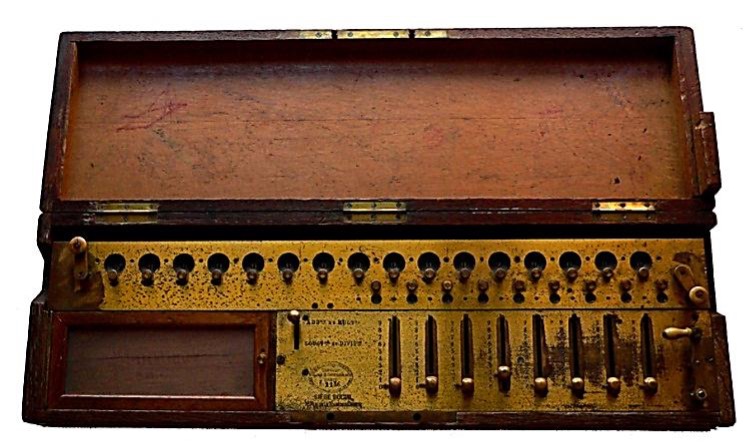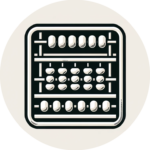THOMAS ARITHMOMETER, 1820
Inventor
Xavier THOMAS DE COLMAR (France 1785-1870)
Invention date
Patent No. 1420, Nov 18, 1820
Manufacturing date:
1865 (n°2236)
Manufacturing location
France
Manufacturer
X. THOMAS DE COLMAR
Dimensions
L 50 H 10 W 18
Reference Number
027

History and Functionality
The Frenchman Xavier THOMAS de COLMAR registered a patent in November, 1820 for a machine that could do the four operations. Multiplication and division are broken down respectively into addition and subtraction. The machine uses as transfer mechanism a stepped-drum system invented by LEIBNIZ (1646-1716) and a sliding carriage that carries the result mechanism and a lap counter. It then took THOMAS de COLMAR thirty years to develop a machine that could be mass produced. Production began in 1851.
Commercialization of THOMAS’s arithmometer launched the calculating machine industry. For nearly forty years, from 1851 to 1887, it was the only type of calculating machine in industrial production, and it sold worldwide. Towards the end of this period, the first two companies to manufacture clones appeared: BURKHARDT, a German company (1878) and LAYTON, an English company (1883).
Because of its simplicity, reliability and robustness, it was widely used by banks, insurance companies, and administrative offices. Around 1873, for the first time in the history of calculating machines, the production of arithmometers amounted to over 1,000 machines.
By his death in 1870, Xavier THOMAS de COLMAR had produced about 800 machines. His son produced as many.
About The Inventor
Xavier Thomas de Colmar, born in 1785 in France, was a pivotal figure in the history of mechanical calculators. He is most renowned for his invention of the Thomas Arithmometer, the first commercially successful mechanical calculator and a landmark development in the field of computational technology.
Introduced in the 1820s, the Thomas Arithmometer revolutionized the way calculations were performed in various fields, including business, engineering, and astronomy. This device was capable of performing all four basic arithmetic operations: addition, subtraction, multiplication, and division. Its robust and practical design made it the first calculator to be widely used in offices and scientific institutions, effectively replacing the need for tedious manual calculations.
The significance of the Arithmometer lies in its innovative mechanism, which was based on the stepped drum or Leibniz wheel. This mechanism allowed for more efficient and accurate calculations, setting the standard for many future mechanical calculators. The Thomas Arithmometer remained in production for nearly a century, a testament to its effectiveness and enduring utility.
Xavier Thomas de Colmar’s contribution to the field of computing goes beyond the invention of a machine. He brought computational tools into the commercial and practical realm, making them accessible to a broader audience. His work marked a significant transition from theoretical or experimental calculating devices to practical, reliable tools that could be used in everyday work. The Thomas Arithmometer is not only a milestone in the history of mechanical calculators but also a symbol of the industrial and technological advancements of the 19th century.
Thomas de Colmar’s legacy is that of a pioneer who played a key role in shaping the landscape of modern computing.

